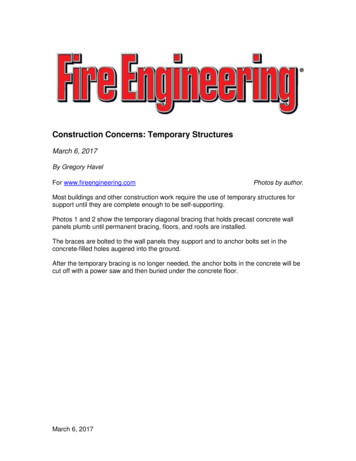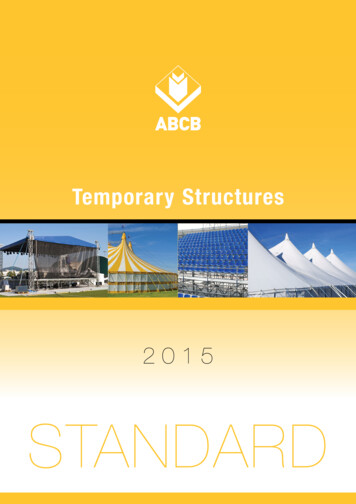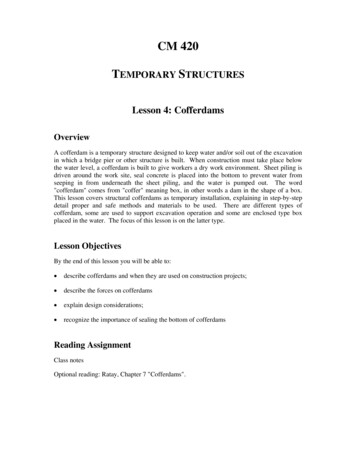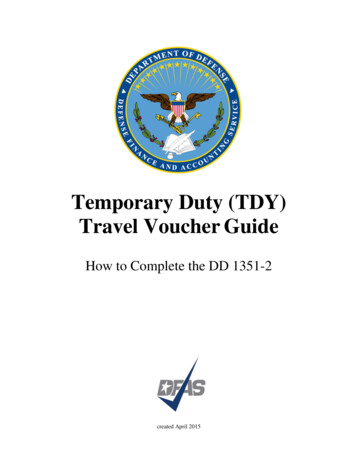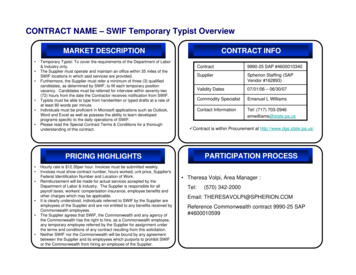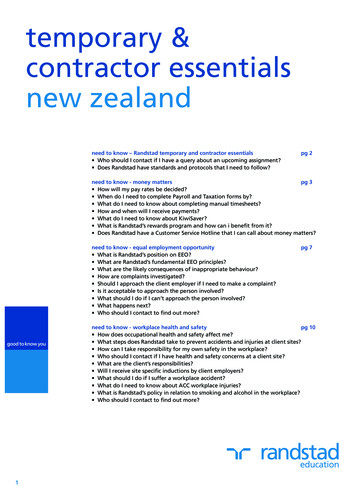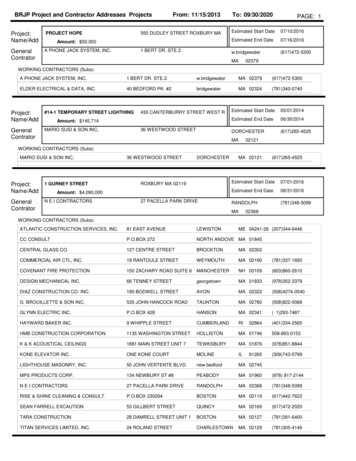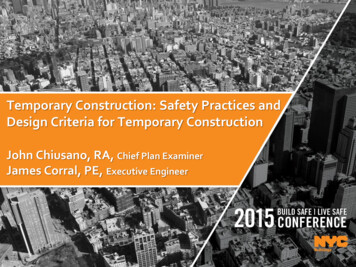
Transcription
Temporary Construction: Safety Practices andDesign Criteria for Temporary ConstructionJohn Chiusano, RA, Chief Plan ExaminerJames Corral, PE, Executive Engineer
American Institute of ArchitectsContinuing Education SystemThe NYC Department of Buildings is a registered Provider with The AmericanInstitute of Architects Continuing Education Systems (AIA/ CES). Credit earnedon completion of this program will be reported to AIA/CES for AIA members.Certificates of Completion for both members and non-AIA members areavailable upon request.This program is registered with the AIA/CES for continuing professionaleducation. As such, it does not include content that may be deemed orconstructed to be an approval or endorsement by the AIA of any material ofconstruction or any method or manner of handling, using, distributing, ordealing in any material or product.Questions related to specific materials, methods, and services will beaddressed at the conclusion of this presentation.2
Course DescriptionThis course will open by providing an overview of demolition and thecomplexities of doing so in our urban environment. Then, we willsupplement this broad topic of demolition by examining safety practicesand design criteria for some temporary structures that are commonlyused during both construction and demolition.We will approach the safety and design requirements of fences,sidewalk sheds, supported scaffolds, and suspended scaffolds throughthe eyes of the 2014 New York City Building Code. Real life examplesof deficiencies witnessed in each respective structure will be providedto help illustrate their importance.3
Learning ObjectivesAt the end of this course participants will be able to: Understand critical elements of demolitions and the variouscomponents required to effectively safeguard the adjacent public andproperty. Participants will realize design load requirements for temporarystructures in order to safely design, build and maintain them. Recognize the distinctions between the 2008 NYC Building Codeand the 2014 New York City Building Code to determine howamended requirements affect the design, construction andmaintenance of temporary structures. Understand the difference between different types of temporarystructures as well as importance of the “temporary” distinction.4
Course OutlineThis course will consist of the following five sections:1. Demolition Overview2. Design, Construction, and Maintenance of:A.B.C.D.3.4.Sidewalk ShedsSupported ScaffoldsSuspended ScaffoldsFencesLoads on Temporary InstallationsOther Temporary Structures.5
Demolition- By the Numbers80200018007016006014005012001000800 10 Story New BuildingPermits4010 Story Plus NewBuilding Permits 10 Story DemolitionPermits3010 Story DemolitionPermits6002040020001006
How to file a Full Demolition Plan1)2)3)4)5)6)7)8)File application in the borough and pay all required feesBring the folder to the BEST Squad (log in cover sheet)Review conducted by the BEST SquadIf approved then pre-demo is scheduled and conductedIf approved the permit is pulled24 hour notice call (212)-393-2550Demo work startsWhen demo work is completed the contractor calls forsign off9) BEST conducts sign off inspection10)Sign off is entered into BIS7
Understanding Key Demolition terms(BC) Section 3302 – DefinitionsWhat Is Demolition? Full Demolition – the dismantling, razing, or removal of allof a building or structure, including all operations incidentalthereto Partial Demolition – the dismantling, razing, or removal ofstructural members, floors, interior bearing walls, and/ orexterior walls or portions thereof, including all operationsincidental thereto8
Understanding Key Demolition termsWhat Is The Difference Between Handheld Equipment AndMechanical Equipment? Handheld Device (Demolition) – Equipment, mechanicalor non-mechanical, utilized to physically demolish abuilding or structure, or elements of a building or structure,that is held, lifted, moved, and operated by a single person.A handheld device shall also include any item accessory tosuch equipment, including but not limited to a compressor,regardless if such accessory item is held, lifted, moved,and operated by a single person. A handheld device doesnot include remote controlled equipment.9
Understanding Key Demolition termsWhat Is The Difference Between Handheld Equipment AndMechanical Equipment? Mechanical Demolition Equipment – Mechanically drivenor powered equipment that is utilized to physically demolisha building or structure, or elements of a building orstructure, either within or exterior to the building orstructure, or that is utilized to move debris or material withinthe building or structure. Mechanical demolition equipmentshall not include mechanically driven or poweredequipment that is utilized to move debris or material outsideof the building or structure.10
Understanding Key Demolition termsInterior Mechanical Demolition11
Where to find Demolition Requirements(BC) Section 3306 - DemolitionBC 3306.1 – ScopeBC 3306.2 – Protection of Pedestrians and Adjoining PropertiesBC 3306.2.1 – Safety ZonesBC 3306.3 – NotificationBC 3306.3.1 – The permit holder shall notify the department via phone orelectronically at least 24 Hours, but no more than 48 hours prior to thecommencement of such workBC 3306.3.2 – Notification of adjoining property owners. Adjoining propertyowners shall be notified of upcoming demolition operations in writing not lessthan 10 days prior to the scheduled starting date of the demolition .12
Where to find Demolition RequirementsBC 3306.4 – Mechanical DemolitionBC 3306.5 – Submittal Documents for DemolitionExceptions: Section 3306.5 shall not apply to:1. Demolitions performed as emergency work .2. The full demolition of a detached one-, two-, or three-familydwelling .3. The removal, with mechanical demolition equipment, of foundationsand landscaping elements 4. The full demolition of a fully detached building that is three stories orfewer and with a floor area of 5,000 square feet (464.5 m2) or lessper story .5. Partial demolition operations accomplished without any mechanicaldemolition equipment, other than handheld devices, provided suchwork is a minor alteration or ordinary repair13
Where to find Demolition RequirementsBC 3306.5.1 – Required documents1.2.3.4.5.6.Identification of the StructureIdentification of all Mechanical Equipment other then handheldMeans and MethodsScope of Proposed Mechanical Equipment Work and/or Hand WorkPositioning of EquipmentCalculations – Loads ImposedBC 3306.5.1.1 – Submittal documents for full or partial demolitionusing mechanical equipment other than handheldBC 3306.5.2 – Maintenance of submittal documentsBC 3306.5.3 – Filing requirements14
Where to find Demolition RequirementsBC 3306.6 – Special InspectionsBC 3306.7 – Demolition of weakened structuresBC 3306.8 – Demolition sequenceBC 3306.8.1 – Structural steel, reinforced concrete, and heavy timberbuildingsBC 3306.8.2 – Masonry buildings with wooden floors15
Where to find Demolition RequirementsBC 3306.9 Safeguards. Demolition shall be conducted in accordancewith the requirements of Sections 3306.9.1 through 3306.9.14BC 3306.9.1 – Utilities and service linesBC 3306.9.2 – Party wall exits, fire exitsBC 3306.9.3 – DustBC 3306.9.4 – Water accumulation16
Where to find Demolition RequirementsBC 3306.9.5 – Temporary elevators and standpipe systemsBC 3306.9.6 – Sprinkler systems SP PermitMaintained as Non-Automatic SystemsCapped Immediately Below the Floor being DemolishedSiamese Connection to be painted (903.6), marked with a RedLight and Maintained Free from Obstructions17
Where to find Demolition RequirementsFor the Removal of Damaged Sprinklers you will also need a CCD1anda Letter of No Objection from FDNYImportant to remember if the building has an existing Stand Pipe(SD)System the system must be maintain in a state of readiness, you willneed: SD Permit Air Pressurized Alarm System for All Existing Standpipes (SD) Application Submitted by Design Professional Electrical Permit18
Where to find Demolition RequirementsBC 3306.9.7 – Use of explosives. The use of explosives in demolitionoperations shall conform to the requirements and limitations imposedby the New York City Fire Code and Section 3312BC 306.9.8 – Hazards to be removed. Prior to the commencement ofdemolition operations, hazards shall be removed in accordancewith Sections 3306.9.8.1 through 3306.9.8.4BC 3306.9.8.1 – Combustible content. Prior to the commencement ofdemolition operations, the area authorized to be demolished by thework permit shall be thoroughly cleaned of combustible content anddebris, including but not limited to building contents and exteriorfinishes, down to the structural elements19
Where to find Demolition RequirementsBC 3306.9.8.2 – Asbestos. Prior to the commencement of demolitionoperations, all asbestos shall be removed from the area authorized tobe demolished by the department work permit, and certification to thateffect shall be filed with the DOB and DEP .BC 3306.9.8.3 – Glass. Prior to the commencement of demolitionoperations, all glass located in the area authorized to be demolished bythe work permit, including but not limited to glass in windows, doors,skylights, and fixtures, shall be removedBC 3306.9.8.4 – Steam and fuel. Prior to the commencement ofdemolition operations, all pipes, tanks, boilers, or similar devicescontaining steam or fuel and located in the area authorized to bedemolished by the work permit shall be purged of such steam or fuel20
Where to find Demolition RequirementsBC 3306.9.9 – Stairs. All enclosed vertical shafts and stairs shall bemaintained enclosed at all floors except the uppermost floor beingdemolished, and all work on the uppermost floor shall be completedbefore stair and shaft enclosures on the floor below are disturbed. Allhand rails and banisters shall be left in place until actual demolition ofsuch floor is in progressBC 3306.9.13 – Rodent Extermination. A licensed exterminator shalleffectively treat the premises for rodent extermination as per therequirements of the Department of Health and Mental HygieneBC 3306.11– Completion of demolition operations. All work required forstructural stability and permanent waterproofing of adjacent buildingsmust be completed prior to demolition sign-off21
Required Forms for DemolitionSection 5: Job ApplicationType: Demolition22
Required Forms for DemolitionItem 8D: Street Frontage (linear feet)Item 9A: Review Is Requested UnderWhich CodeItem 9C: Site SafetyItem 9D: Requesting legalization ofwork where there are no workwithout permit violations Landmarks “Little E” Filing to address violations23
Required Forms for DemolitionItem 13D: Building Type – 1, 2 or 3Family, Or Other; MixedUse BuildingItem 13E: Building Height, Stories, &Dwelling Units (Existing/ Proposed)Item 14: Fill – Onsite, Off-site, OrUnder 300 Cubic YardsItem 18: Fire Protection Equipment24
Required Forms for DemolitionItem 21: Demolition DetailsItem 22: AsbestosAbatement Compliance25
Required Forms for DemolitionDS1 Demolition Submittal Certification Form Must be submitted by the professional preparing demolition submittalplans – required prior to permit when performing full or partialdemolition work as per BC 3306.5. This certification form must besubmitted together with the planItems 3A & 3B:Full/ Partial Demolition Description and Certification (BC 3306.5) Mechanical equipment with general descriptions (handheld & other) Non-mechanical means & methods Work on building interior, exterior or both26
Required Forms for DemolitionBEST Recommendation forMechanical Means Demolition In order to request arecommendation in favor of usingmechanical means for demolition,you must complete and submit(BEST 4)to BEST at time ofsubmittal of pre-demolitionapplication The Borough Commissioner’sapproval still required afterreceiving BEST Recommendation.27
Required Forms for DemolitionAll demolition applicationsmust be pre-filed prior torequesting a pre-demolitioninspection from BEST BEST will only acceptapplications for inspection priorto demolition (B Form 2A) withthe nine digit BIS Job number onthe upper right hand corner ofthe form28
Required Forms for DemolitionImportant for DemolitionItem 3 – Special Inspection items: Structural stability- existingbuildings may be a requirement forthe adjoining buildings duringdemolition operations Mechanical demolition29
Required Forms for DemolitionImportant for DemolitionItem 3 – Special Inspection items: Sprinkler Systems Standpipe Systems30
Demolition Checklist PlansDemolition Checklist Is the minimumstandards for requireditems on thedemolition plan31
Temporary Installations by the NumbersIn 2014: 7,186 Fence Permits were issued 3,029 Supported Scaffold permits were issued 5,799 Sidewalk Shed permits were issued 10,930 Suspended Scaffold notifications were received 6,951 of which were C-Hook notifications 3,979 of which were Outrigger Scaffold notifications32
Sidewalk Sheds 2014 NYC Building Code§ 3307.6§ 3307.6.2 Where Required. A sidewalk shed shall be installed and maintained to protectall sidewalks, walkways, and pathways within the property line of the site, and all publicsidewalks that abut the property.33
Sidewalk Sheds - Where RequiredSidewalk sheds shall be installed andmaintained to protect all sidewalks, walkways,and pathways within the property line of a site,and all public sidewalks that abut the propertyas follows:1. Below a scaffold, mast climber or chute2. When a structure or facade higher than40 feet is to be constructed, altered,maintained, or repaired3. When a structure higher than 25 feet is tobe demolishedThe decking of the sidewalk shed shall extendthe full length of the area plus an additional 5feet beyond the length*. The decking mustextend the full width of the protected
Participants will realize design load requirements for temporary structures in order to safely design, build and maintain them. Recognize the distinctions between the 2008 NYC Building Code and the 2014 New York City Building Code to determine how amended requirements affect the design, construction and maintenance of temporary structures.
